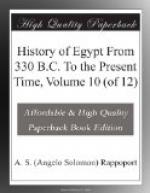[Illustration: 081.jpg Alexandrian lady, attired in BOMBYX silk]
Cos continued always in the power of the Ptolemies, who used it as a royal fortress, occasionally sending their treasures and their children there as to a place of safety from Alexandrian rebellion; and there the silk manufacture flourished in secret for two or three centuries. When it ceased is unknown, as it was part of the merchants’ craft to endeavour to keep each branch of trade to themselves, by concealing the channel through which they obtained their supply of goods, and many of the dresses which were sold in Rome under the emperors by the name of Coan robes may have been brought from the East through Alexandria.
One of the most valuable gifts which Egypt owed to Ptolemy was its coinage. Even Thebes, “where treasures were largest in the houses” never was able to pass gold and silver from hand to hand without the trouble of weighing, and the doubt as to the fineness of the metal. The Greek merchants who crowded the markets of Canopus and Alexandria must have filled Lower Egypt with the coins of the cities from whence they came, all unlike one another in stamp and weight; but, while every little city or even colony of Greece had its own coinage, Egypt had as yet very few coins of its own. We are even doubtful whether we know by sight those coined by the Persians In the early years of Ptolemy’s government Ptolemy had issued a very few coins bearing the names of the young kings in whose name he held the country, but he seems not to have coined any quantity of money till after he had himself taken the title of king. His coins are of gold, silver, and bronze, and are in a fine style of Greek workmanship. Those of gold and silver bear on one side the portrait of the king, without a beard, having the head bound with the royal diadem, which, unlike the high priestly crown of the native Egyptian kings, or the modern crown of gold and precious stones, is a plain riband tied in a bow behind. On the other side they have the name of Ptolemy Soter, or King Ptolemy, with an eagle standing upon a thunderbolt, which was only another way of drawing the eagle and sun, the hieroglyphical characters for the title Pharaoh.
[Illustration: 082.jpg Egyptian coinage]
The gold coins of Egypt were probably made in Alexandria. The coins are not of the same weight as those of Greece; but Ptolemy followed the Egyptian standard of weight, which was that to which the Jewish shekel was adjusted, and which was in use in the wealthy cities of Tyre and Sidon and Beryttus. The drachma weighs fifty-five grains, making the talent of silver worth about seven hundred and fifty dollars. Ptolemy’s bronze coins have the head of Serapis or Jupiter in the place of that of the king, as is also the case with those of his successors; but few of these bronze pieces bear any marks from which we can learn the reign in




